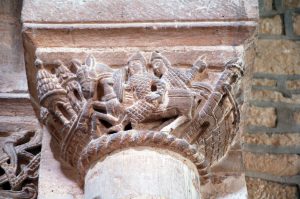It has been a busy year for the Warhorse project, with work progressing on multiple fronts. We thought that a quick end of year blog would be a useful way of summarising some of the key activities and achievements so far and for alerting everybody to our packed programme for 2020.
In terms of our team of post-doctoral researchers, we have welcomed on board Dr Gary Baker, who, working alongside Prof Rob Liddiard, has been making great strides in capturing documentary references to the royal network of studs. Preliminary results are really exciting, and we can report that the project has already generated an initial map of how the royal studs were distributed across the English landscape, which we think is the first time this has been done.
We are also delighted to welcome to the team Rob Webley, who from spring 2020 will be working on the material culture work package of our project, examining all things metal and equine from harness pendants to horseshoes. Rob has a fantastic pedigree of working with medieval objects through the Portable Antiquities Scheme, and we look forward to developing this side of the project with him on board. We have already made good progress in collecting together some excellent examples of medieval representations of horses on wall paintings and sculpture (see images below, taken by Prof Oliver Creighton).
On the zooarchaeological front we have set up our Geometric Morphometrics Lab with new digital photogrammetry and X-ray facilities, and 2020 will see an energetic programme of data collection in the UK and Europe led by our Project Officer Dr Carly Ameen and our dedicated PhD student Helene Benkert, working with Prof Alan Outram.
Our programme of impact and outreach activities also continues to gain momentum, with project members present at the Royal Armouries’ Easter Joust, at the Tewkesbury re-enactment and at the Being Human Festival in Exeter Cathedral. Team members have already contributed to the Leeds International Medieval Congress, the Society for Medieval Archaeology Student Colloquium, the International Council for Archaeozoology GMM Conference, Paris, and the Postgraduate Zooarchaeology Forum in Yerevan, Armenia.
If there is one thing that excites our project team most is the potential for integration between our different strands of evidence. We have our first Steering Group in March 2020, and while it is still early days for our work, with over two years still to run, we will be turning our minds to the ways our different work packages need to interact and add value to produce new insights.
2020 will also see team members analysing and measuring horse armour, and trying to draw our first connections between surviving material culture in modern-day museum collections and the dry bones of long-dead medieval horses. The challenge is to understand what the ‘live’ horses of the medieval period looked like when all we have are their bony endoskeletons and their humanly created steel exoskeletons. So bring on the next stage of our project …


I have recently been alerted to the Warhorse Project.
You might be interested in a paper I published in 2019 entitled ‘The Medieval Powys Warhorse’ in Montgomeryshire Collections 107 (2019), 31-44. I could send you an offprint if you provide a postal address. I also have some unpublished supplementary information from my researches which I could also make available if you wish.
Thank you.
Hi Dr. Barton,
Thank you for this kind offer. We would love to see your work of course as it sounds very complimentary to the goals of our project. If you would like to email me (C.Ameen@exeter.ac.uk) we can discuss how best to do this given the current climate. Very much looking forward to discussing this further with you.
All the best,
Carly Ameen
(Warhorse Research Fellow)